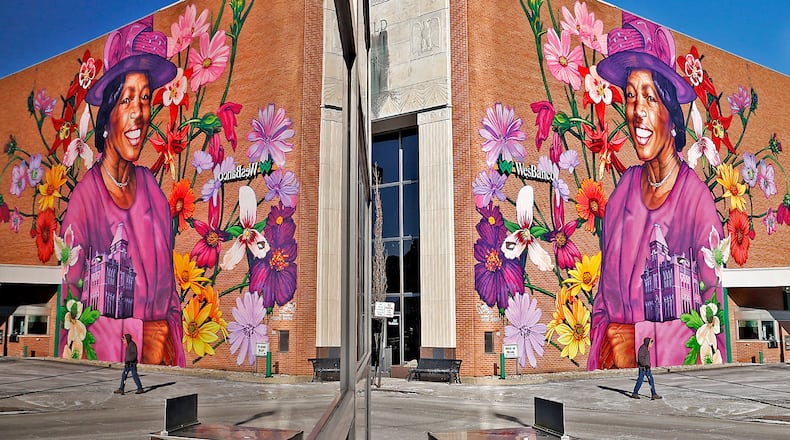Two other public displays recognizing Black history in Springfield have come in the last three years. Historical markers now honor George and Sarah Gammon at the Gammon House, an Underground Railroad safehouse, and honor Daniel Rudd, a Black journalist, Catholic activist, lecturer and advocate for racial equity.
Remembering and pointing to stories like that of the Gammons, Moseley and Rudd is crucial to progress, according to Dale Henry, president and groundskeeper of the Gammon House.
“African American history is American history,” he said as Black History Month began. “These stories haven’t been told or have been ignored for a long time.”
Hero in a story of hope
Turner Foundation historian and director of revitalization Kevin Rose, who spearheaded the Moseley mural effort along with other members of the Springfield Public Art Committee, the Greater Springfield Partnership and Westcott House, said the project came to be after years of research into the life and work of Moseley.
The undertaking was something he pursued as a part of a broader effort in 2020 to tell the stories of remarkable women in Clark County’s history that was waylaid by the pandemic, but he began working on learning more about her history 10 years before.
Rose researched Moseley through old newspaper clippings and other records. She had no children and thus no grandchildren, but Rose and others worked with her grandnieces and grandnephews to make decisions with internationally recognized artist Gaia for the Moseley mural, finished last fall.
The mural did not start solely as a project to honor Mosely specifically. Rather, artist Gaia requested focus group sessions and other conversations to hear from local leaders to hear about how his work could elevate unsung heroes.
Rose ultimately suggested Moseley as a hero in a story of hope.
“When we talk about stories we want to focus on, stories we want to elevate, this one really makes sense,” Rose said. “A lot of what Hattie was doing was fighting against hatred.”
Moseley, originally from Georgia, is credited with helping to end Jim Crow policies and assist Black people and women with registering to vote. She also led public protests against Fulton School’s segregation.
News articles in 1922-1923 shared some details about this, but little information about the boycotts she led is available, Rose said. With the digitization of records, this may change.
“There’s still so much more research to do,” Rose said. “Something more will come to light, I’m hopeful, on these events she participated in and led.”
Most photos of Moseley feature her signature large hat, but also pictured Moseley with a stern demeanor. Relatives of the activist told mural organizers that they wanted people driving into Springfield to be greeted by Moseley’s contagious smile, as she was known by her loved ones for her joy and laughter.
“They said that was Aunt Hattie,” Rose said. “She was this really larger-than-life personality. She was friendly, she was warm. She would laugh, smile. They wanted this joyful representation of her. It turned out beautifully.”
‘We need to keep stepping up’
Springfield NAACP president Denise Williams said the realities of people who came before her are not only inspiring, but also illuminating. The experiences of people in Springfield’s past can help inform the city’s future leaders and point to opportunities they can pursue.
“We desperately need to honor Black leaders,” she said. “These are the lessons we need to teach our kids. We need to keep stepping up and keep highlighting these people. They’re our heroes, our history, our present.”
Credit: Bill Lackey
Credit: Bill Lackey
A year before the Moseley mural was unveiled downtown, another Black leader from Springfield was memorialized in the form of a historical marker recognized by the state.
The marker honoring Black journalist and advocate for Roman Catholicism Daniel Rudd, rests by St. Raphael’s church on East High Street and is one of nine historical markers in the city.
Rudd was born into slavery in Kentucky in 1854, but moved to Springfield after the Civil War, where he became a member of the St. Raphael parish.
Rudd was a newspaperman, lecturer and advocate for racial equity, and he created the Ohio Star Tribune in 1885. His paper was later renamed The American Catholic Tribune, which was the only Catholic newspaper owned by a Black man at the time. He also helped chair the Afro-American Press Association, according to Ohio History Connection.
Henry, who oversees Springfield’s historic stop on the Underground Railroad, said he’s happy to see the remembrance of Black leaders who contributed to bringing Springfield forward, a mission Gammon House is also carrying forward.
The past prepares for the future
The Gammon House, located at 620 Piqua Place, is one of three Underground Railroad safehouses still in existence in Ohio that were owned and operated by a family of color.
The house was built in 1850, the same year as the passage of the Fugitive Slave Act. Owners George and Sarah Gammon, who were free people of color, risked imprisonment and large fines for aiding and providing shelter to runaway slaves, according to Henry.
The Gammons and the Gammon House received a historical marker from the state in 2020, following years of work that began in the 1990s to restore the building.
Henry, who also works as a tutor at Fulton Elementary, said understanding history is crucial to moving forward. Teaching young people about the past helps them understand obstacles they may be facing today.
“We try to prepare them for the future and have them realize that African Americans have played a significant role in the development of the country,” Henry said. “There are some outstanding stories and inspirational people that they need to be aware of.”
Gammon House has seen changes over its restoration. Henry said the board that oversees the house purchased the field that sits in front of the house from an area church, and he and others are working on plans to create an interpretive center to greet those visiting Gammon House and to host programming.
“We want to try to be the repository for African American history for Springfield and Clark County,” he said.
Giving a breath of life to the Gammon House is part of an overall revitalization effort to the city’s south side, Henry said. Gammon House board members are working with other community organizations to bring opportunity to the area.
“We’re trying to do everything we can to play a role in the overall improvement of the south side,” he said.
Credit: Bill Lackey
Credit: Bill Lackey
About the Author



